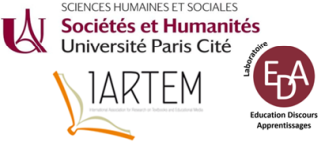The starting point of this paper is a didactic development project at the University of South-Eastern Norway, funded by the Norwegian Directorate for Higher Education and Skills (2022-2024). The project is titled "Learning materials and learning resources in the classroom at the secondary level" (LærUng) and is a project that aims at developing digital learning resources that can be applied in teacher education and in further education for teachers. The learning resources concern how teachers reflect on and apply learning materials and learning resources in secondary school.
Today, teacher's reflections on and their practical use of educational materials are characterized by complexity, diversity, and rapid changes. Teachers daily face choices that require insight and understanding of how different learning resources can be applied in their classrooms. The consequences of the Covid-19 pandemic, where remote learning and digital instruction often replaced in-person teaching, have highlighted the need for enhanced and explicit competence in how to use a variety of learning materials and resources. This need is also underscored in international research (Gouëdard, Pont & Vienet, 2020; Reimers & Sleicher, 2020; Gissel & Hansen, 2021).
In many Norwegian classrooms, teachers apply both analog and digital materials. They apply materials that are already ‘didacticised', such as textbooks and educational portals, as well as ‘semantic' learning materials such as literature and films. (On the different classifications, see for example Bundsgaard & Hansen, 2011). The teachers' professional judgement is of crucial importance in their use of learning materials, and this judgement is related to changes in the curriculum and the quality of the learning materials that they have access to (Christensen et.al, 2023). Teacher education institutions need to provide teachers and teacher students with qualifications that strengthen their abilities to make informed and competent decisions in their daily professional practices. In the LærUng-project we explore how we can develop professional skills regarding the use of educational materials. However, it is crucial that the training is profession-oriented and practical, with courses developed in close collaboration with both the field of practice (schools and school owners) and students in teacher education.
To meet this need and contribute in making teacher education more relevant for practice in schools, we have collaborated with teachers from two secondary schools in Norway in developing digital learning resources regarding the practical use and reflections on learning materials. These resources include videos from authentic classroom situations in the subjects of Norwegian (L1), social studies and natural sciences. We also sought instruction that addresses the three interdisciplinary cross-curricular topics; Health and life skills, Sustainable Development and Democracy and Citizenship. These themes are anchored in the Norwegian curriculum and are to be integrated into school subjects (Ministry of Education and Research, 2017). The learning resources that we develop will be piloted in teacher education programs at the University of South-Eastern Norway this spring. Furthermore, we will evaluate the resources and collect data to develop further knowledge on how teacher education can provide the students with knowledge and competence on the use of learning materials in their future daily practices as teachers. We will particularly focus on students' reflections on the use of learning resources (analogue and digital) in classroom situations. We will present results from the students' evaluations at the conference, as well as show examples of the digital learning resources.
Bundsgaard, J. & Hansen, T.I. (2011). Evaluation of learning materials: A holistic framework. Journal of Learning Design, 4(4), 31–44. http://dx.doi.org/10.5204/jld.v4i4.87
Christensen, A. S., Mortensen-Buan, A.-B. ., Nordberg, K., & Roos, M. . (2023). Teachers' judgement, learning materials and curriculum: Navigating in a changing educational landscape. IARTEM E-Journal, 15(2), 1–13. https://doi.org/10.21344/iartem.v15i2.981
Gissel, S. T. & Hansen, T. I. (2021). Learning materials between didactic potential and control. In Roos, M, Berge, K. L., Edgren, H., Hiidenmaa, P. & Matthisen, C. (Eds.). Exploring Nordic Education. Brill l Sense.
Gouëdard, P., Pont, B. & Viennet, R. (2020). Education responses to COVID-19: shaping an implementation strategy. OECD Education Working Papers, No. 224. https://doi.org/10.1787/8e95f977-en
Ministry of Education and Research. (2017). Core curriculum: values and principles for primary and secondary education. The National curriculum for the Knowledge Promotion 2020. https://www.regjeringen.no/contentassets/53d21ea2bc3a4202b86b83cfe82da93e/core-curriculum.pdf
Reimers, F. M., & Schleicher, A. (2020). A framework to guide an education response to the COVID-19
Pandemic of 2020. https://globaled.gse.harvard.edu/files/geii/files/framework_guide_update1_0.pdf

 PDF version
PDF version
